Growing Catnip and Using It for the Anxious Child
Growing catnip in your medicinal herb garden increases the biodiversity of your garden and gives you useful leaves for medicinal teas and glycerites. The dried leaves can be used as a mild sedative for kids and adults to relieve everyday stress, gently.
Do you have catnip in your medicinal garden? It was cultivated in ancient times by the Romans as a medicinal herb. The dried leaves were used as a mild seasoning and medicinally to relieve the pressure of an often stressful life.
In modern times catnip is associated with cat toys that make your furry feline run around acting crazy. But did you know that catnip has the opposite effect on people? While catnip makes your cat rev up and do funny things, it helps your kids calm down when they get stressed.
Grow catnip in your yard and put its calming properties to work for your family.
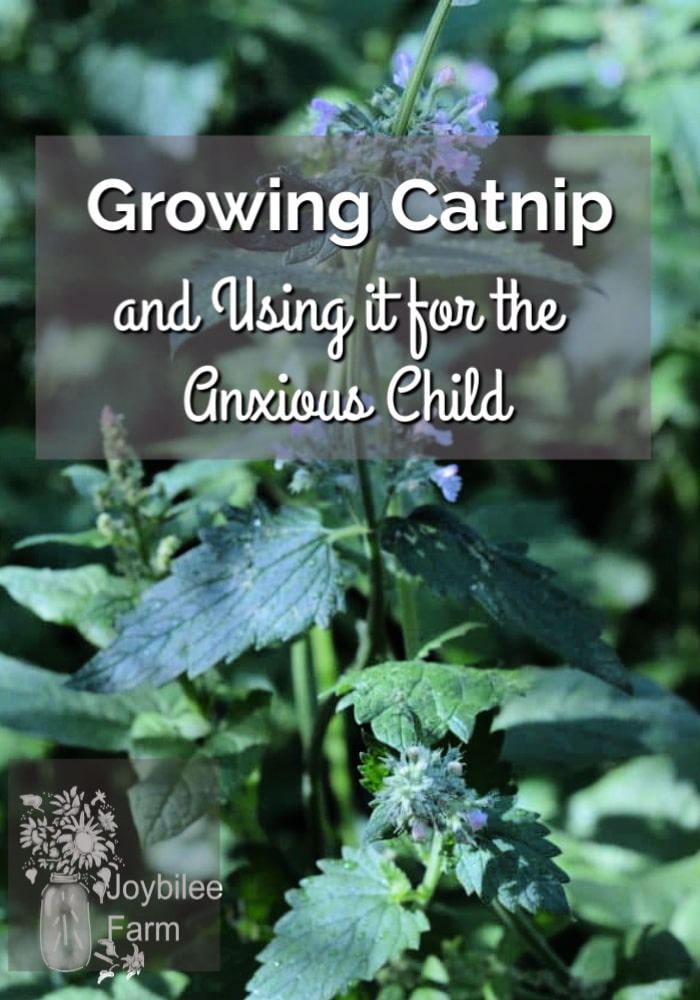
What is the difference between Catnip and Catmint?
Catnip (Nepeta cataria)
While both are perennials and members of the Labiatae family, catnip is considered less showy than its sister catmint (Nepeta x faassenii), the former having white flowers on 1 to 3 feet stalks.
It is also more inclined to attract cats to your garden. The struggle between cats and catnip growers has been raging for centuries, so if you have cats in the area, you’ll want to apply some method to keep them from rolling over the plant and destroying it. Two methods that have proven effective are placing 18-inch dowels or bamboo stakes inside the plant, or making a chicken wire cover so the plant can grow through it.
Medicinally, catnip is used as a digestive aid, tonic, and sleeping aid – consider it a mild nightcap, suitable for everyone. These are the herbs we will use for the remedies below.
Catmint (Nepeta x faassenii)
Catmint is similar to catnip but does not stimulate cats. It is a low-growing mounded plant with attractive, gray-green foliage and beautiful blue flowers that appear in early summer. It is often used as a bedding plant for the cottage border.
Both catnip and catmint attract bees and other beneficial insects. Catnip usually only blooms once each season, but when it does, it attracts bees and other nectar feeders.
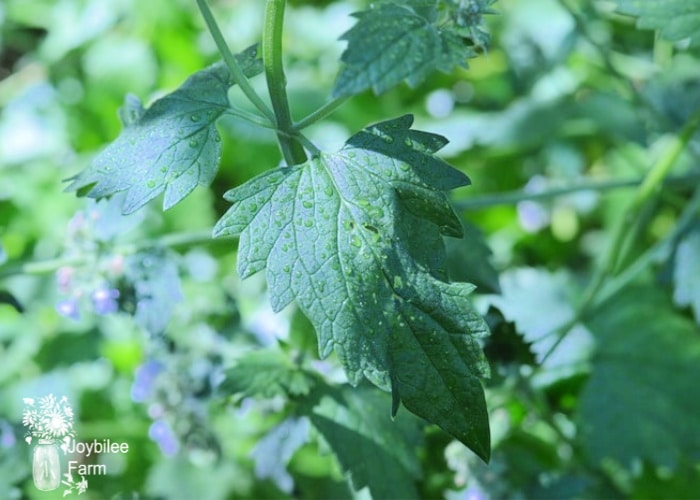
Growing Catnip
Hardiness: Zone 3 to 8
Soil: pH 6.6, average, well-drained
Sunlight: full sun to partial shade
Both catnip and catmint are considered heat and drought tolerant, making them excellent plants for dry garden areas. Give the plant plenty of room, overcrowded plants can lead to powdery mildew or leaf spot, especially in hot, humid climates.
Catnip is a member of the mint family and will take over whatever area you give it, they can be aggressive growers. Consider planting it in an out-of-the-way area where it can naturalize or containing it in pots.
Deer and most other herbivores are not attracted to catnip.
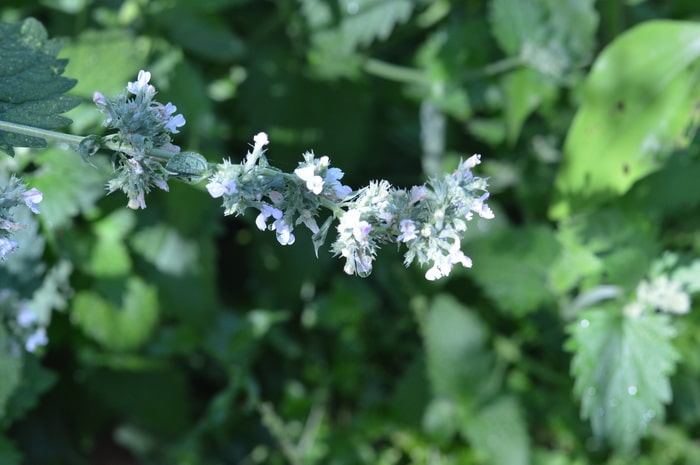
Growing Catnip from Seed
Propagation is by seed or root division. Established plants can also be divided by cutting the root mass in half and replanting. The plants can get fairly large (3 feet tall), so grow them where they have adequate space
Prepare the garden soil outdoors after the last frost or start the seed inside 4 weeks before the last frost date. The seed is very small, so barely cover it to a depth of 1/8″. Protect from your cats as the plants are growing. As a perennial, it will flower the second year after planting.
Once the plants are well established, they should survive in the garden for several years. To contain the plant to its specified area, remove the blooms before they set seed. If uncontained it will self-seed and can spread, almost to the point of becoming weedy.
Many seed companies sell catnip seeds.
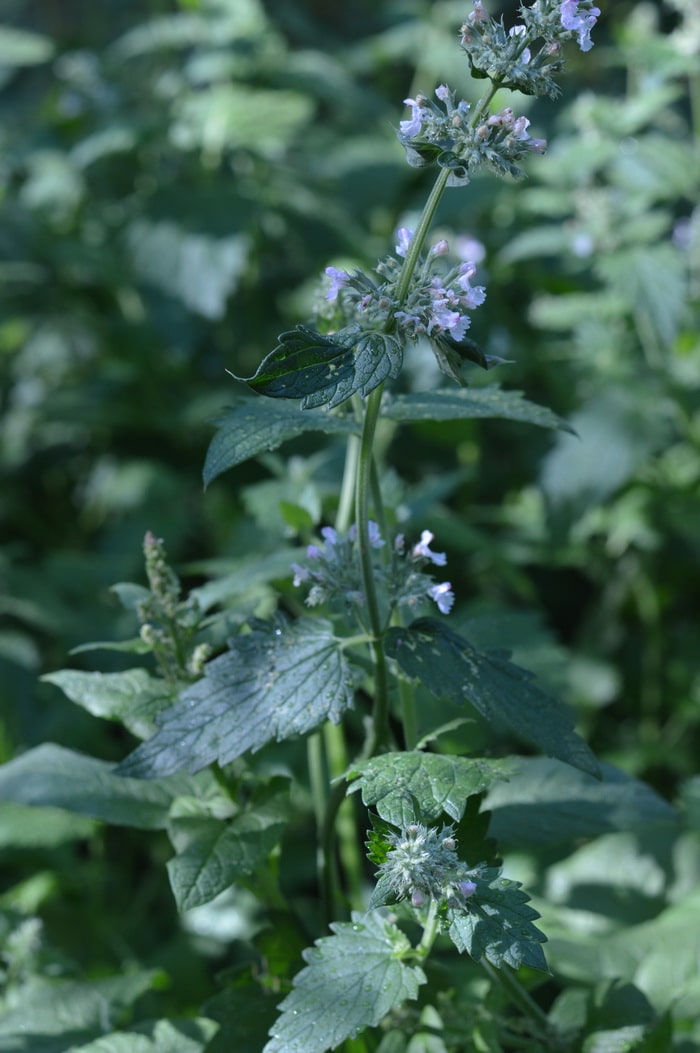
Harvesting Catnip
Catnip can be used fresh, dried, or frozen in ice cube trays for both culinary and herbal use. Harvest the leaves as soon as flowers begin to bloom by cutting off the stalks and allowing them to dry in a cool, ventilated area or in the dehydrator.
Strip the dried leaves from the stalks and store whole dried leaves in an airtight container until you are ready to use them.
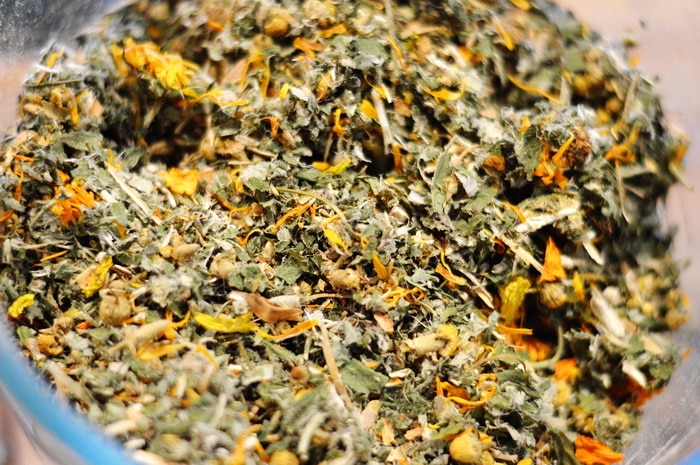
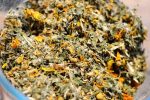
Anxious Kids Tea Recipe
- Prep Time: 5 minutes
- Cook Time: 10 minutes
- Total Time: 15 minutes
- Category: tea
Description
Sip a cup of Anxious Kids Tea before bedtime or any time that your child is feeling anxious.
Ingredients
- 1 part dried Catnip
- 1 part dried Chamomile
- 1 part dried Lemon balm
- 1/4 part fresh or dried lemon zest.
Instructions
- Combine the dried herbs in a dry, airtight container and label with the recipe.
- Store in a dark cabinet until ready to use for tea or tincture.
To Use:
- Put 2 to 3 teaspoons full of the dried herbs into a French press or small teapot.
- Add a cup of freshly boiled water and steep for 10 minutes, strain.
Notes
All these herbs are safe for kids and generally considered safe in food amounts during pregnancy and lactation. This recipe tastes pretty good, but it can also be sweetened with honey. Avoid raw honey with infants and toddlers less than 2 years of age.
Nutrition
- Serving Size: 1 cup
Anxious Kids Tea Recipe with Catnip
Ingredients:
- 1 part dried Catnip
- 1 part dried Chamomile
- 1 part dried Lemon balm
- 1/4 part fresh or dried lemon zest.
All these herbs are safe for kids and generally considered safe in food amounts during pregnancy and lactation. This recipe tastes pretty good, but it can also be sweetened with honey. Avoid raw honey with infants and toddlers less than 2 years of age.
Method:
Combine the dried herbs in a dry, airtight container and label with the recipe. Store in a dark cabinet until ready to use for tea or tincture.
Put 2 to 3 teaspoons full of the dried herbs into a French press or small teapot. Add a cup of freshly boiled water and steep for 10 minutes, strain.
To use: Sip a cup of Anxious Kids Tea before bedtime or any time that your child is feeling anxious.
Print
Anxious Child Glycerite
- Prep Time: 10 minutes
- Cook Time: 4 weeks infusion
- Total Time: 10 minutes prep + 4 weeks infuse
Description
Glycerin is a colorless, odorless, sweet syrup and by-product of soap manufacturing. It mixes with water and is soluble in alcohol. It is used in place of alcohol when making herbal tinctures, for those with liver disease, alcohol allergies, or a history of alcoholism. Often glycerin is used when making recipes used by children. Glycerin infusions are called glycerites.
Ingredients
- 1 part parts Tulsi (Holy Basil)
- 1 part stinging nettle
- 1 part catnip
- 1 part dandelion root
- 1/4 part ginger root.
- Glycerin plus water (3:1 ratio)
Instructions
- Wash and sanitize your equipment.
- Place the dried herbs in a Mason jar, filling it no more than half full. The dried herbs will absorb the moisture and swell in the jar.
- Combine 3/4 cup glycerin with 1/4 cup water for every cup of glycerin you need to cover your herbs in the mason jar. The actual amount you will need depends on the volume of glycerite you want to make.
- Pour glycerin-water mixture over the herbs until there is at least 2 inches of liquid above the herbs.
- Using chopsticks or a butter knife, displace any air bubbles that may have formed.
- Cap tightly and label the jar with the contents and the date. Place it in a dark cupboard.
- Shake the jar daily (or as often as you think about it). After 4 weeks, strain out the herbs and re-jar the remaining liquid.
Notes
To Use:
- 1/2 teaspoon in a 1/2 glass of water for children under 12
- 1 teaspoon in a 1/2 glass of water for ages 12 and older.
Nutrition
- Serving Size: 1/2 teaspoon
Anxious Child Glycerite
Another recipe for the anxious child is a glycerite. Glycerin is a colourless, odourless, sweet syrup and by-product of soap manufacturing. It mixes with water and is soluble in alcohol. It is used in place of alcohol when making herbal tinctures, for those with liver disease, alcohol allergies, or a history of alcoholism. Often glycerin is used when making recipes used by children. Glycerin infusions are called glycerites.
Since glycerin is made by hydrolysis it begins with a liquid oil often soybean oil, palm kernel oil, or coconut oil. If you have allergies in your family you will want to source your glycerin from the plant origin to be sure you aren’t introducing known allergens. If sourcing glycerin from palm oil, be sure the source is sustainable like this glycerin.
Using a combination of soothing herbs, this recipe helps with focus and concentration, calming an anxious mind.
Ingredients:
- 1 part parts Tulsi (Holy Basil)
- 1 part stinging nettle
- 1 part catnip
- 1 part dandelion root
- 1/4 part ginger root.
- Glycerin plus water (3:1 ratio)
Method:
To make a glycerin tincture (glycerite).
- Wash and sanitize your equipment.
- Place the dried herbs in a Mason jar, filling it no more than half full. The dried herbs will absorb the moisture and swell in the jar.
- Combine 3/4 cup glycerin with 1/4 cup water for every cup of glycerin you need to cover your herbs in the mason jar. The actual amount you will need depends on the volume of glycerite you want to make.
- Pour glycerin-water mixture over the herbs until there are at least 2 inches of liquid above the herbs.
- Using chopsticks or a butter knife, displace any air bubbles that may have formed.
- Cap tightly and label the jar with the contents and the date. Place it in a dark cupboard.
- Shake the jar daily (or as often as you think about it). After 4 weeks, strain out the herbs and re-jar the remaining liquid.
To use:
1/2 teaspoon in a 1/2 glass of water for children under 12
1 teaspoon in a 1/2 glass of water for ages 12 and older.
Catnip in the garden and in the apothecary
Catnip is easy to grow, beneficial for pollinators, and useful in the apothecary to reduce stress and anxiety. Safe for children it is a beneficial herb to add to your repertoire of herbal allies.
More ideas for growing and using herbs
Catnip is a good companion plant to use in your vegetable garden, provided you give it an area by itself so that it is free to spread. Learn how adding herbs to your vegetable garden can increase your yields, improve the biodiversity of your garden and help with natural pest control, here.



Leave a Reply